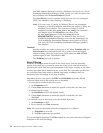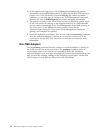4: ATTR(=,"ifDescr");
5: ATTR(=,"ifType");
6: ATTR(=,"locIfReason");
FETCH
1: IPNAME($SOURCE_ADDR);
MAP
hostname = $F1;
sub_origin = $V4;
status = CLOSED;
interface_index = $V3;
interface_description = $V4;
interface_type = $V5;
reason = $V6;
END
Error File
It is possible to selectively activate tracing for any module of an adapter (parser,
kernel, select, fetch, map, driver, and so forth) and for any level of error tracing. A
different log file can be specified for each module/level pair. To see a continuous
flow of adapter processing with tracing, change all occurrences of /dev/null to the
same output file. Keep in mind that these tracing features can consume large
amounts of disk space.
Note: The AS/400 adapters run in batch as an AS/400 job. Every job writes
messages (completion, error, and informational) to a job log. See the AS/400
adapter chapters for more information about debugging and tracing options.
Specifications in the error file allow you to configure tracing options for an
adapter. An error file usually has an extension of .err; see each specific adapter
chapter for exact file names. An error file is located in the same directory as the
adapter configuration file (see “File Location” on page 9 for details).
Note: The error file name can be specified in the configuration file by the
AdapterErrorFile keyword, as shown in the following example:
AdapterErrorFile=/usr/tecad/tecad_adaptername.err
If you change event definitions in the CDS or format files, you can use the error
file to confirm that the adapter works properly with the new event definitions.
To specify the exact path of the trace file, change all instances of /dev/null in the
error file a file name that you want.
Each line of the error file consists of the following information:
module_name error_level output_file
where:
module_name Specifies the type of function to trace. Valid values are the
following:
ERROR
An error function.
UTILS
A utility function.
PARSER
A parsing function.
Chapter 1. Understanding Adapters 19


















